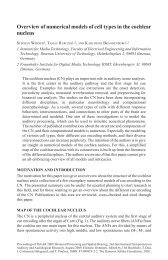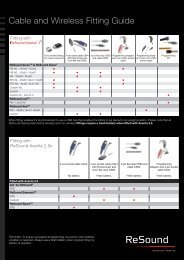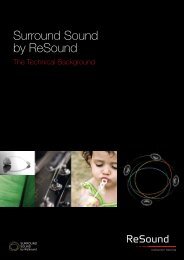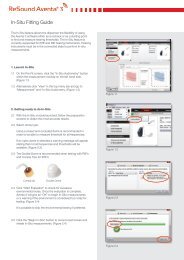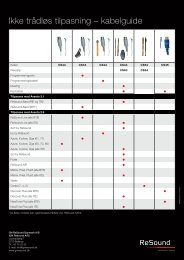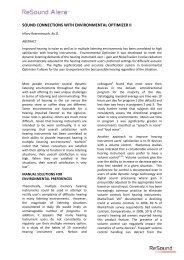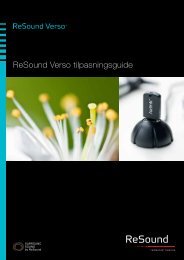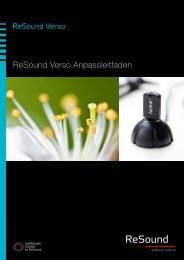ReSound Alera In-Situ White Paper
ReSound Alera In-Situ White Paper
ReSound Alera In-Situ White Paper
Create successful ePaper yourself
Turn your PDF publications into a flip-book with our unique Google optimized e-Paper software.
RESOUND ALERA TM IN-SITU– AN AUDIOMETER THAT FITS IN YOUR HEARING AIDJenny Nesgaard PedersenAbstractPure tone audiometry thresholds are the gold standard for describing hearing acuity. <strong>In</strong>-<strong>Situ</strong> features allow measurementsto be performed in the ear with the expected acoustic parameters in place. The <strong>In</strong>-<strong>Situ</strong> audiometry featureenables hearing care professionals to perform audiometry using the hearing aid as the transducer to present thestimuli. The <strong>ReSound</strong> <strong>Alera</strong> <strong>In</strong>-<strong>Situ</strong> feature offers a means to conveniently and accurately measure patient hearingsensitivity with resulting thresholds comparable to thresholds otherwise obtained with conventional audiometry.INTRODUCTIONPure tone audiometry provides the clinician with frequencyspecific and ear specific information about thehearing sensitivity of the audiology patient. Pure toneaudiometry thresholds are the gold standard for describinghearing acuity.Audiometry has been central to clinical audiology forseveral decades. Systematic descriptions of findingpure tone thresholds through audiometry are describedin the literature dating back to the late 1920s[1] with only few changes being made in the decadesthat followed [2, 3]. Additional tests have since beenadded to the test battery to increase sensitivity to peripheraland central auditory system dysfunction [4, 5].A more recent addition to clinical practice has beenthe introduction of hearing instruments offering in-situfunctionality.This paper will discuss the functionality and benefitsthat can be expected from an <strong>In</strong>-<strong>Situ</strong> audiometry featureas well as the accuracy of hearing sensitivity dataobtained through in-situ testing.IN-SITU FUNCTIONALITY<strong>In</strong>-<strong>Situ</strong> refers to features that allow measurements tobe performed in the ear with the expected acousticparameters in place (i.e. earmold and residual ear canalvolume) [6], using the hearing instrument that thepatient has been or will be fit with. The <strong>In</strong>-<strong>Situ</strong> audiometryfeature enables clinicians and dispensers toperform audiometry using the hearing aid as the transducerto present the stimuli.<strong>In</strong>-<strong>Situ</strong> features have been commercially available inhearing instruments for several years. Previous implementationsincluded the ability to measure mostcomfortable levels (MCL) and uncomfortable loudnesslevels (UCL) while taking into account the residual volumeof the aided ear [7]. More recent implementationsof the in-situ audiometry functionality allow hearingthreshold measurements to be performed. The featurecan be used to find the hearing thresholds of a patientfor the purpose of fitting a hearing aid.Currently available <strong>In</strong>-<strong>Situ</strong> audiometry features enablethe measurement of air conduction hearing thresholds.The measured thresholds should equate to or be veryclose to the thresholds that would have been obtainedwith a conventional audiometer. Previous implementationshave not been able to live up to this expectation.The <strong>ReSound</strong> <strong>Alera</strong> <strong>In</strong>-<strong>Situ</strong> feature was developedbased on a widely used audiometry standard in orderto ensure uniform performance and test results comparableto the results obtained using currently acceptedconventional audiometric procedures [8] .ACCURACY OF <strong>ReSound</strong> <strong>Alera</strong>IN-SITU AUDIOMETRY MEASUREMENTSWhen performing conventional audiometry test-retestvalues are expected to be within 10 dB HL of each other[9]. Previous studies have established that unaidedtest-retest threshold reliability with in-situ audiometry isequivalent to the test-retest reliability expected whenperforming conventional audiometry [6].An investigation aimed at providing insight into the accuracyof threshold measurements performed with <strong>In</strong>-<strong>Situ</strong> audiometry testing was carried out. <strong>In</strong> this pilotstudy, <strong>In</strong>-<strong>Situ</strong> audiometry was performed on 14 testparticipants with a known moderate to severe hearingloss. <strong>In</strong>dividual hearing thresholds were obtainedusing the <strong>ReSound</strong> <strong>In</strong>-<strong>Situ</strong> feature in combination with
the <strong>ReSound</strong> <strong>Alera</strong> TM 967 mini BTE coupled to a customearmold with sealed vent or Comply Snap Tip (forindividuals who did not have a custom earmold). Testparticipant thresholds were verified with conventionalaudiometry (performed using the AURICAL AudiometerModule in combination with a TDH39 transducerand ME70 circum-aural fixtures). The following spreadin data distribution was seen for 500, 1000, 2000 and4000Hz.500HzVariable Min Max MeanConventional Audiometry 10 80 37,500<strong>ReSound</strong> <strong>In</strong>-<strong>Situ</strong> Audiometry 10 85 38,7141000HzVariable Min Max MeanConventional Audiometry 10 80 47,500<strong>ReSound</strong> <strong>In</strong>-<strong>Situ</strong> Audiometry 10 80 46,0712000HzVariable Min Max MeanConventional Audiometry 25 80 56,250<strong>ReSound</strong> <strong>In</strong>-<strong>Situ</strong> Audiometry 30 80 59,0364000HzVariable Min Max MeanConventional Audiometry 35 100 70,893<strong>ReSound</strong> <strong>In</strong>-<strong>Situ</strong> Audiometry 30 100 69,714The data above shows that the mean value for eachfrequency as well as minimum and maximum thresholdvalues for conventional audiometry and <strong>ReSound</strong><strong>Alera</strong> <strong>In</strong>-<strong>Situ</strong> audiometry were within the test-retesttolerance of 10 dB HL of each other.A paired t-test was conducted on the data in order toascertain that no significant statistical difference existsbetween the threshold data obtained using the Re-Sound <strong>Alera</strong> <strong>In</strong>-<strong>Situ</strong> feature and the threshold dataobtained using a conventional audiometer.Prior to running the t-test, threshold values obtainedusing conventional audiometry were subtracted pairwisefrom those obtained using the <strong>ReSound</strong> <strong>Alera</strong><strong>In</strong>-<strong>Situ</strong> test for each test subject for 500, 1000, 2000and 4000Hz. This was done to eliminate the betweensubject differences in hearing threshold, and allow foran analysis of the between test method differencesalone. The results of the statistical analysis are plottedin the figure below (Figure 1).Figure 1: The across subject differential values at 500, 1000, 2000 and4000Hz. Median values are denoted by the red line, the edges of the boxesshow the 25th and 75th percentiles and the whiskers mark the maximum andminimum values of the data set.The p-values of the paired t-tests are plotted at thebottom of figure 1. The test was performed for eachfrequency individually. The null hypothesis was that thedifference in thresholds obtained using in-situ audiometryand conventional audiometry is a random samplecoming from a normal distribution with a mean of 0dB HL and unknown variance, in contrast to the alternativehypothesis that the mean is not 0 dB HL. Theindividual p values in the plot confirm the hypothesis ata significance level of 5 % at each frequency, the differencesbetween test methods was close to or equalto 0dB HL at a statistically significant level (500Hzp=0.15, 1000Hz p=0.26, 2000Hz p=0.27, 4000Hzp=0.83). An additional paired t-test was performedon the average frequency values across subjects, theresult of this analysis was also indicative of any differencebetween test methods being close to or equal to0dB HL at a statistically significant level (p = 0.33, df= 11 at 95 % confidence intervals). The results fromthe two audiometry test methods could in other wordshave come from the same test method.<strong>ReSound</strong> <strong>Alera</strong> <strong>In</strong>-<strong>Situ</strong> audiometry test results arereliable and directly comparable to the thresholds thatwould have been obtained for the same patient usingconventional audiometry.IN-SITU AUDIOMETRY IN AVENTA 3The <strong>ReSound</strong> <strong>Alera</strong> <strong>In</strong>-<strong>Situ</strong> feature can be accessedfrom the pre-fitting screen in Aventa 3. An effort hasbeen made to mimic the functionality that is expectedfrom a conventional audiometer user interface.
A talk over function is available with a linier gain sliderthat allows increases in speaker volume prior tothe establishment of the patients hearing sensitivitythresholds.Figure 4: Talk-over function in the <strong>ReSound</strong> <strong>Alera</strong> <strong>In</strong>-<strong>Situ</strong> moduleIt is also possible to combine thresholds obtained usingconventional audiometry and <strong>In</strong>-<strong>Situ</strong> audiometry.<strong>In</strong>-<strong>Situ</strong> audiometry is available in behind-the-ear modelsat all technology levels of the <strong>ReSound</strong> <strong>Alera</strong>product family.Figure 2: The <strong>ReSound</strong> <strong>Alera</strong> <strong>In</strong>-<strong>Situ</strong> module view in the Aventa 3 fittingsoftwareIt is possible to present pure tone and warble tonestimuli. Stimuli presentation duration can be variedmanually or can be chosen in the user preferences.SUMMARYThe <strong>In</strong>-<strong>Situ</strong> audiometry feature enables clinicians anddispensers to perform audiometry using the hearingaid as the transducer to present the stimuli. This hasthe potential to add convenience and efficiency to thehearing instrument fitting procedure, as the ability topresent stimuli using the hearing instrument requiresless equipment, less space, and is less time consuming.The <strong>ReSound</strong> <strong>Alera</strong> <strong>In</strong>-<strong>Situ</strong> feature offers ameans to measure patient hearing sensitivity with resultingthresholds comparable to thresholds otherwiseobtained with conventional audiometry.Figure 3: Changing stimuli selection and duration in the <strong>ReSound</strong> <strong>Alera</strong><strong>In</strong>-<strong>Situ</strong> module
REFERENCES1. Bunch, C.C., Age Variations in Auditory Acuity.Archives of Otolanryngology, 1929. 9(6): p. 625-636.2. Bunch, C.C., Clinical Audiometry. 1943, St. Louis:Mosby.3. Carhart, R. and J.F. Jerger, Preferred Method forClinical determination of Pure-Tone Thresholds.Journal of Seech and Hearing Disorders, 1959.24(4): p. 330-345.4. Hall, J.W. and H.G. Mueller, Audiologists’ DeskReference. 1997, San Diego: Singular PublishingGroup <strong>In</strong>c.5. ASHA, Preferred Practice Patterns for the Professionof Audiology. 2006.6. Smith-Olinde, L., et al., Test-Retest Reliability of<strong>In</strong>-<strong>Situ</strong> Unaided Threholds in Adults. AmericanJournal of Audiology, 2006. 15: p. 75-80.7. Kiessling, J., <strong>In</strong>-<strong>Situ</strong> audiometry (ISO). Hearing <strong>In</strong>struments,1987. 38(1): p. 28-29.8. ANSI, American National Standard Specificationsfor Audiometers, in S3.6-1996. 1996.9. Schmuziger, N., R. Probst, and J. Smurzynski,Test-Retest Reliability of Pure.Tone Thresholdsfrom 0.5 to 16 kHz using Sennheiser HDA 200and Etymotic Research ER-2 Earphones. Ear &Hearing, 2004. 25(2).M200578-GB-11.04 Rev.A




